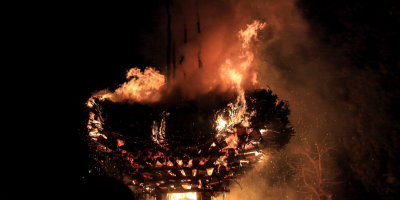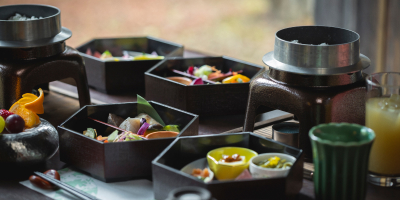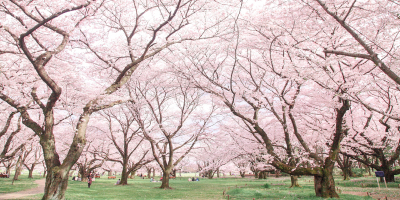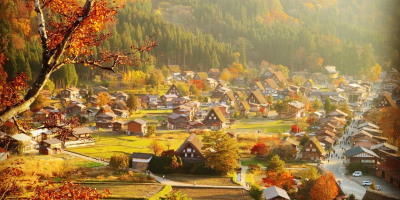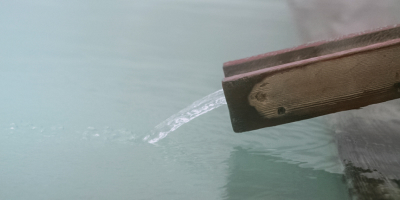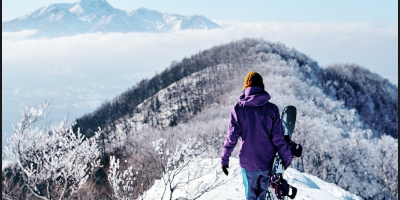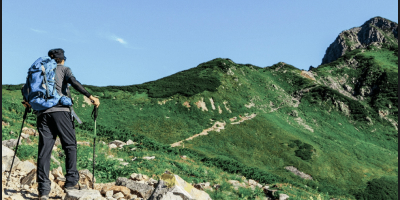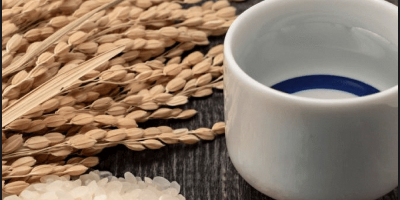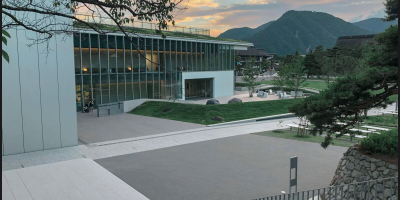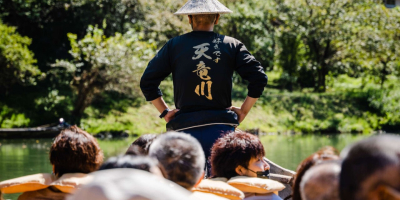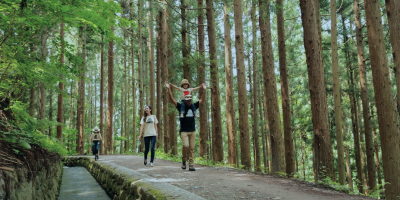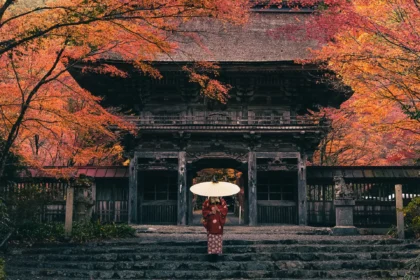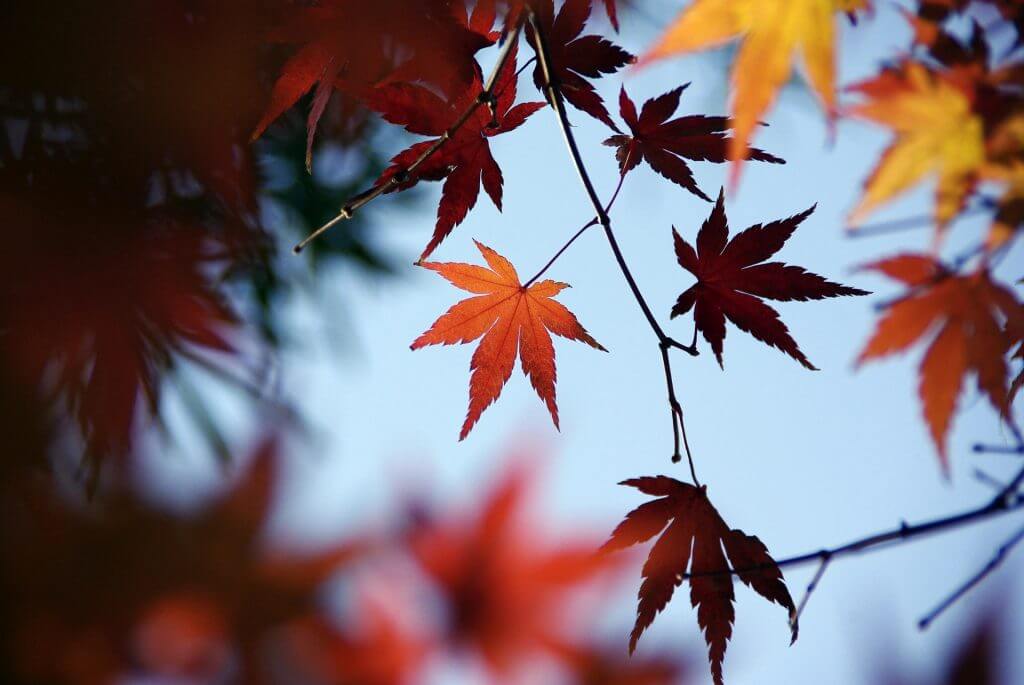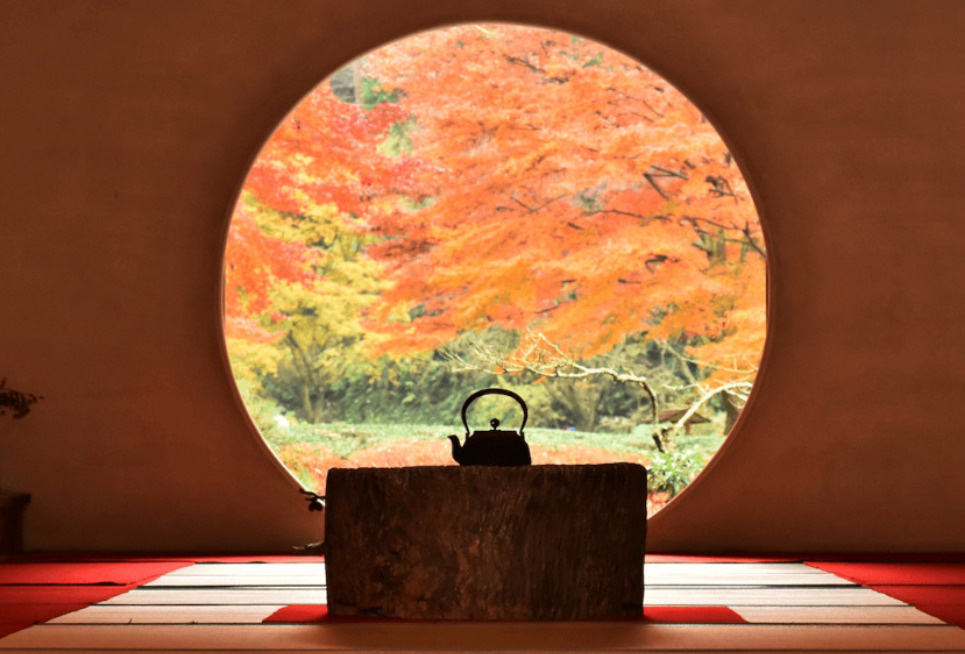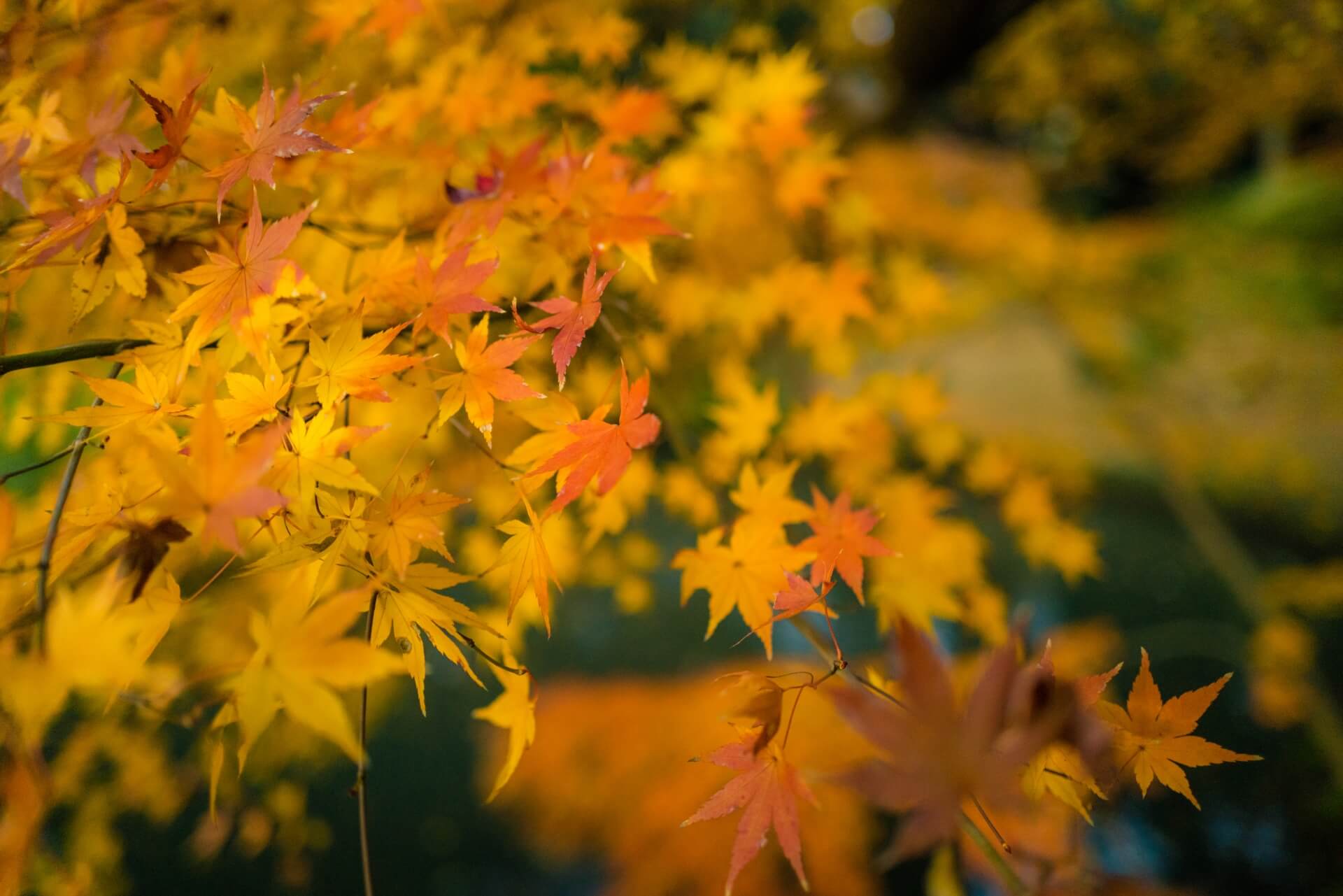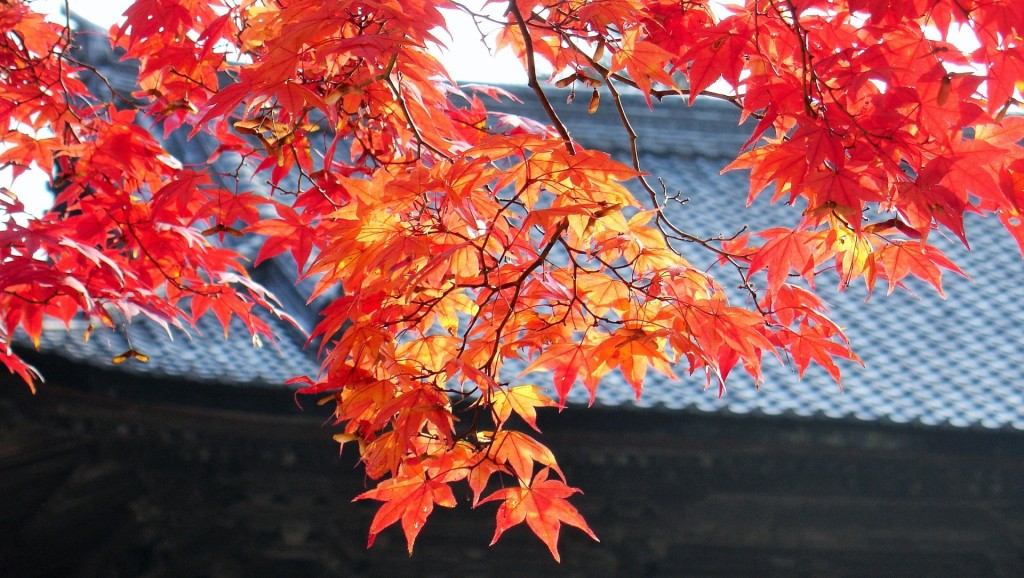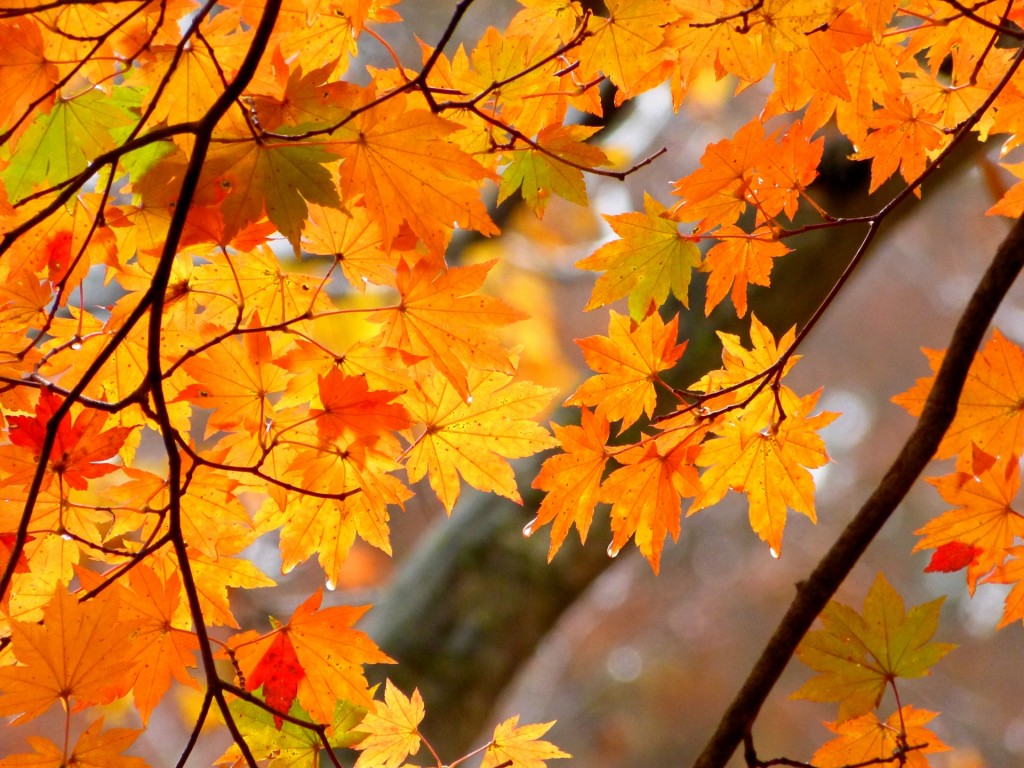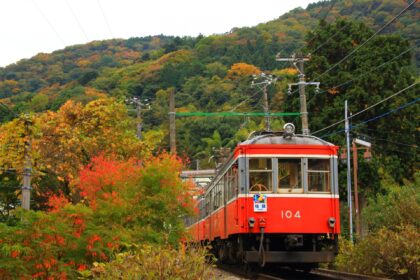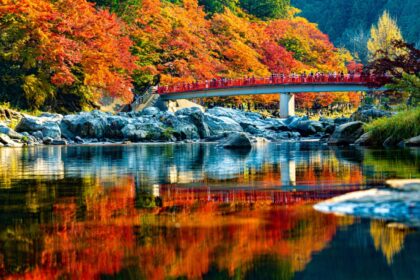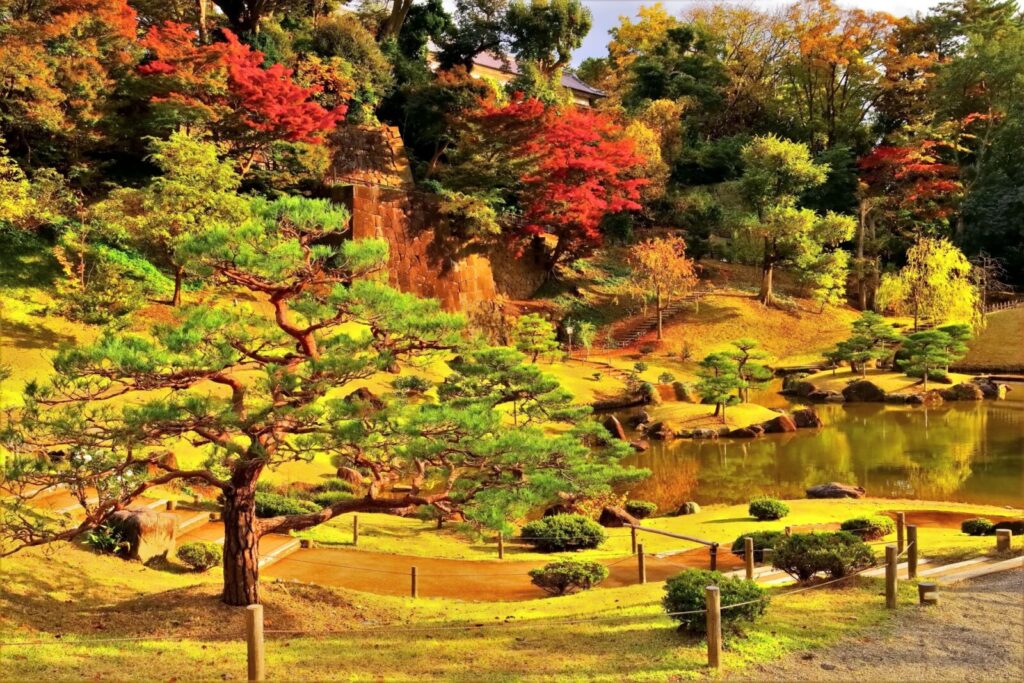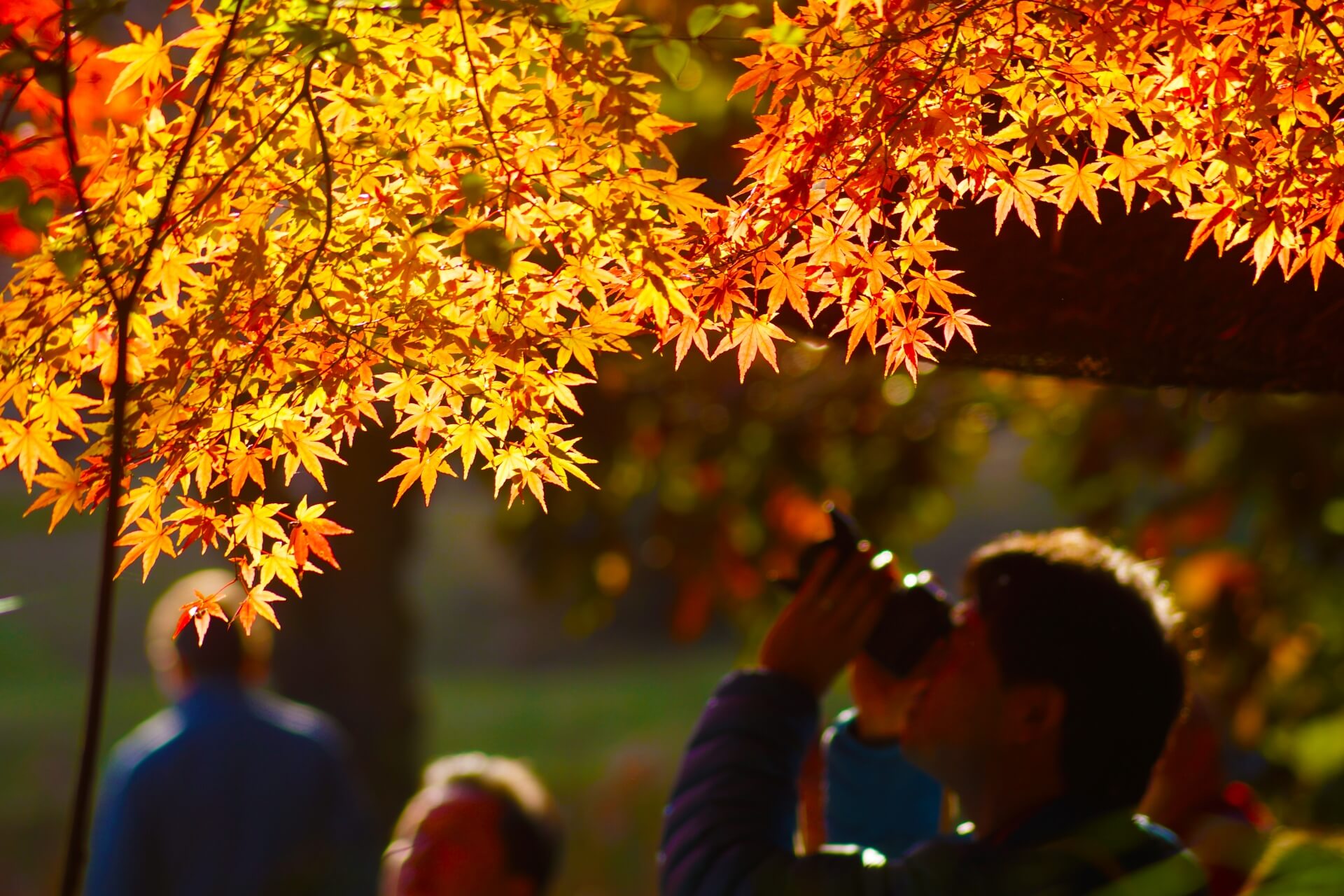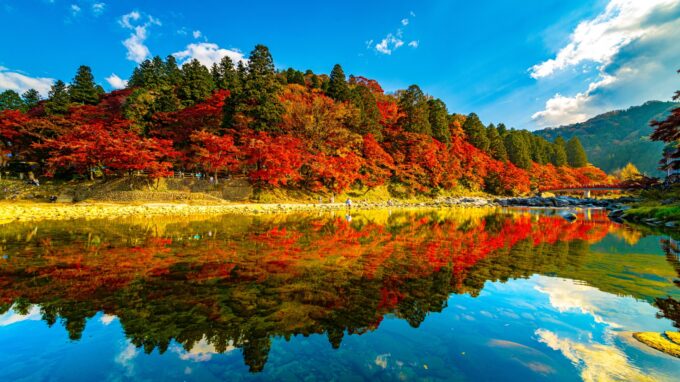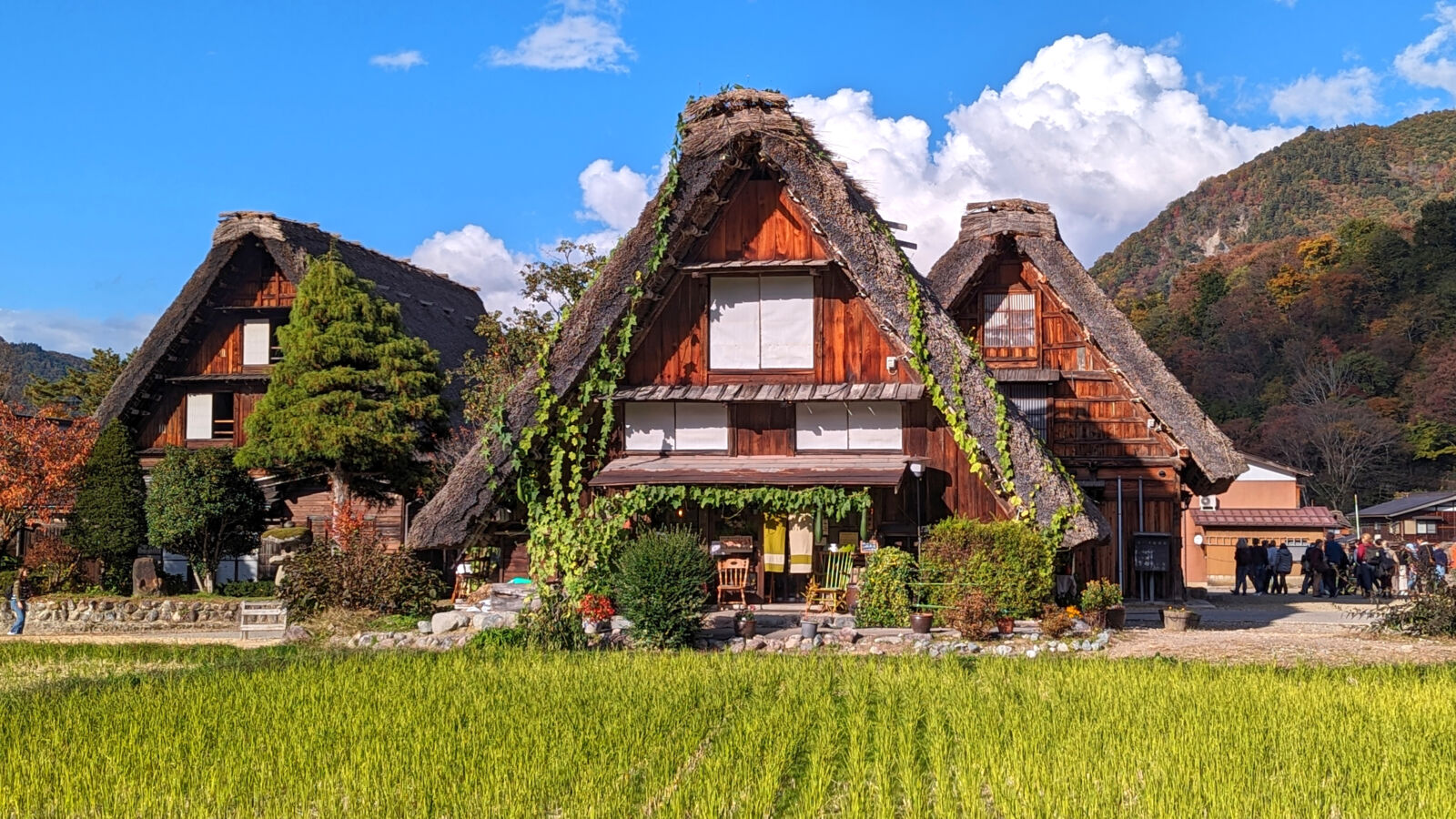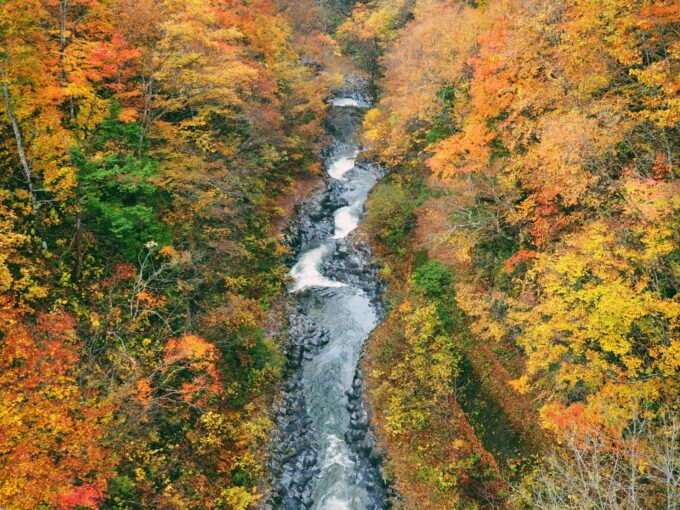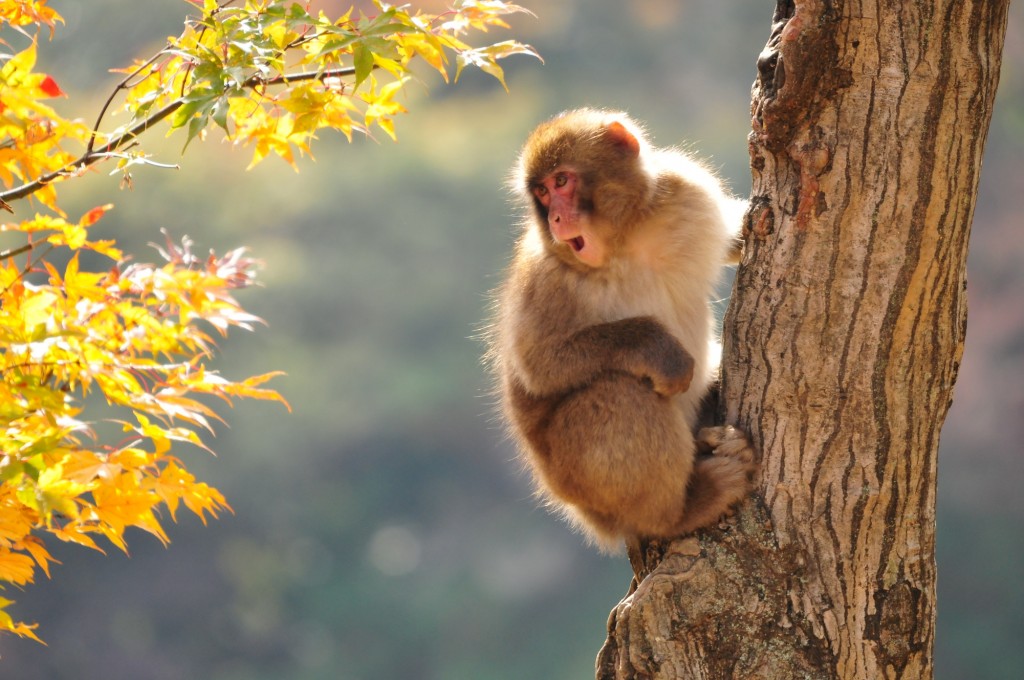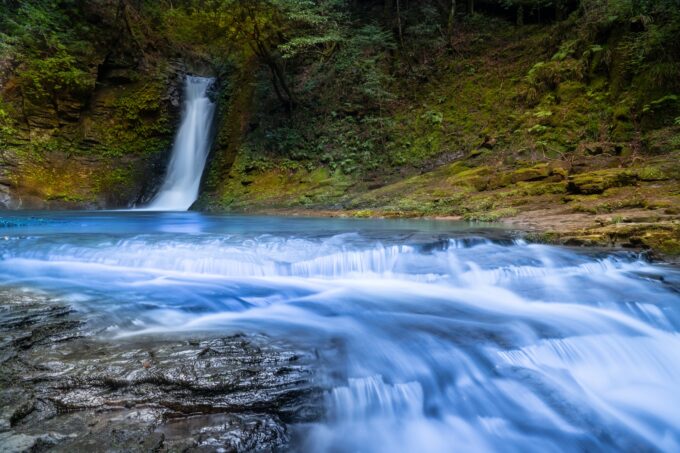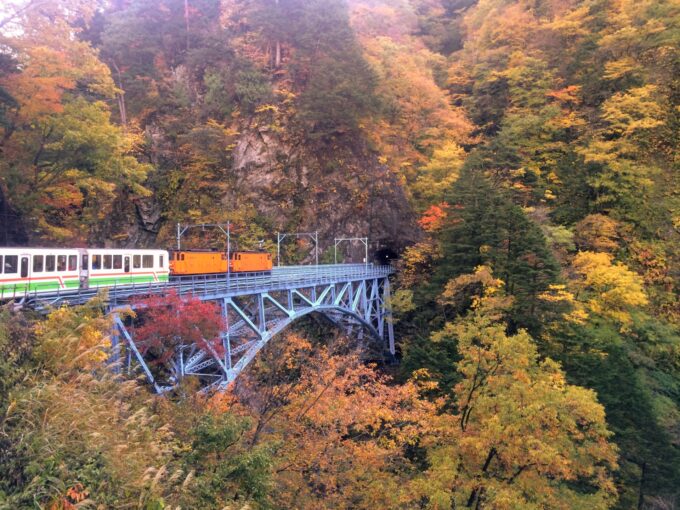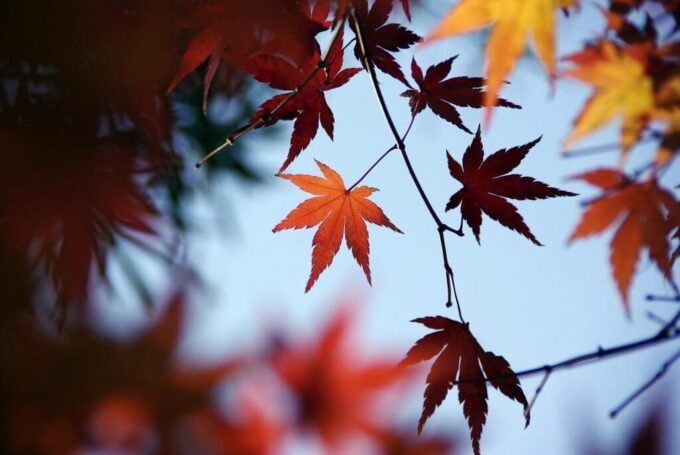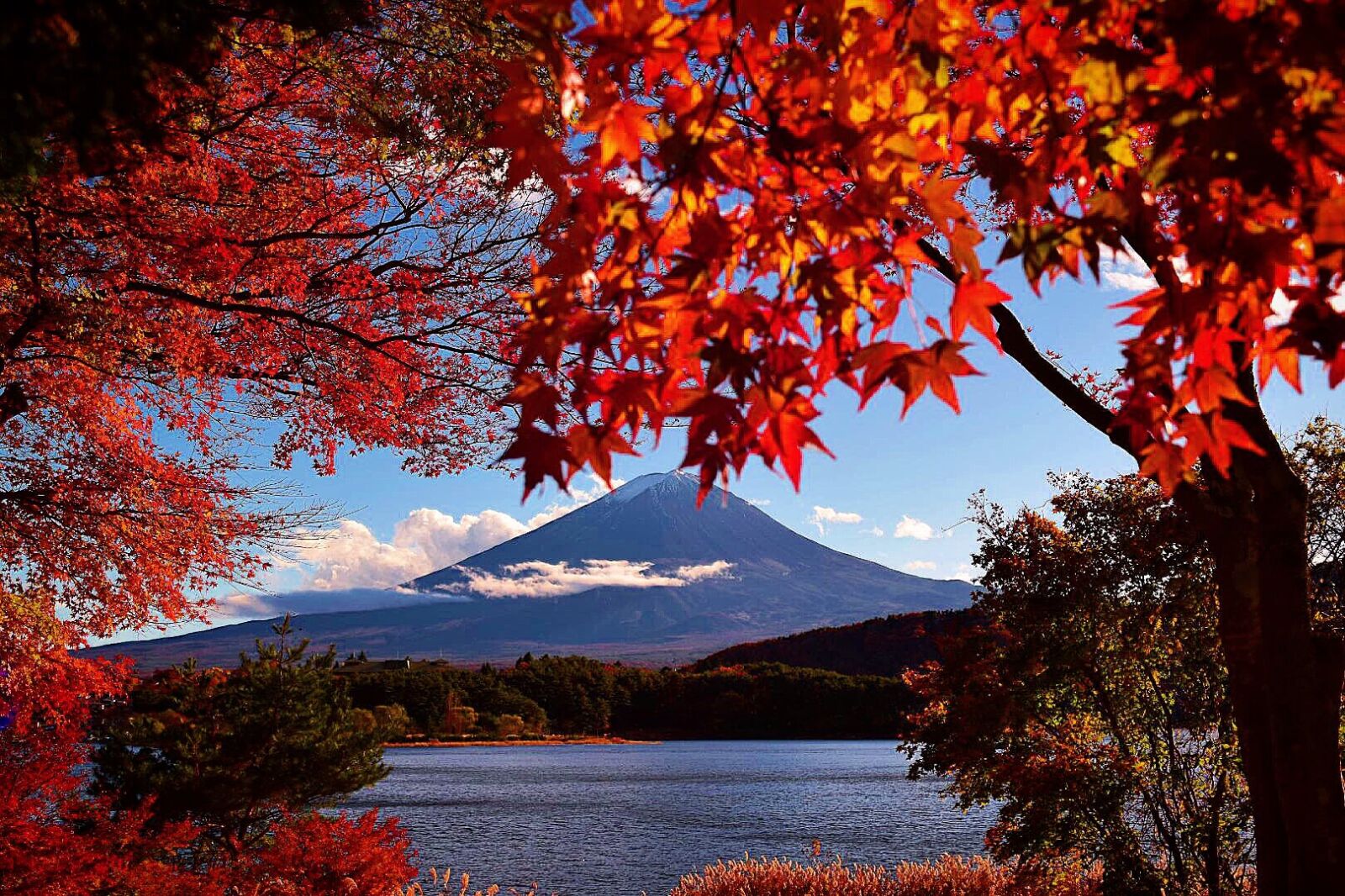
Occurring each year from late September through to mid-December, depending on which region of the country you are visiting, the autumn leaves of Japan rival the legendary cherry blossoms of spring in their fragile beauty and cultural importance.
2025 Autumn Leaves 'Koyo' Forecast
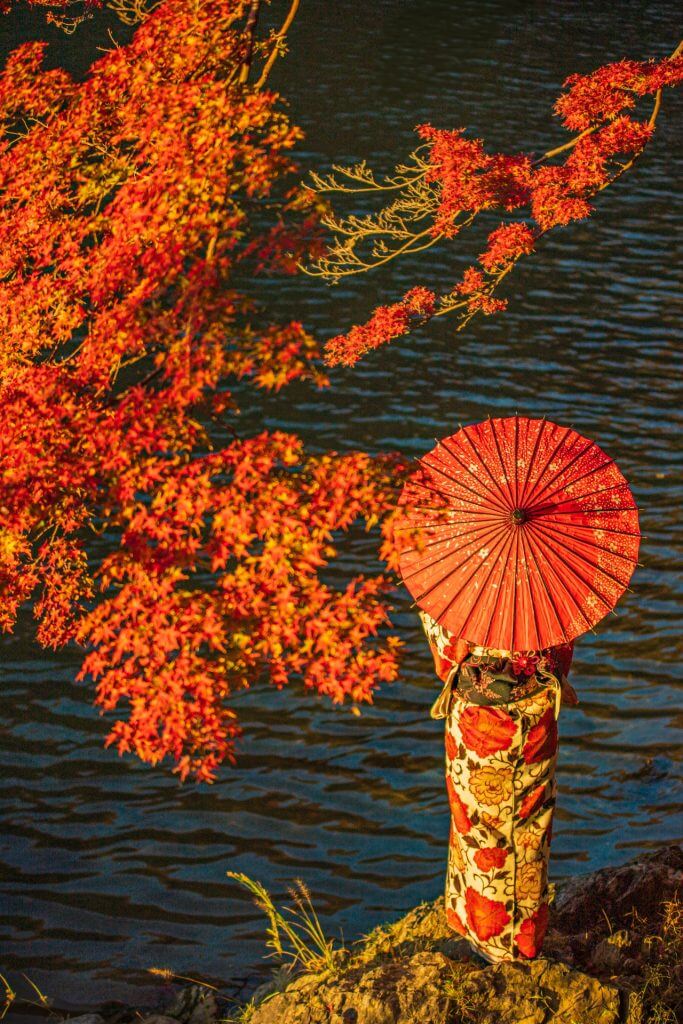
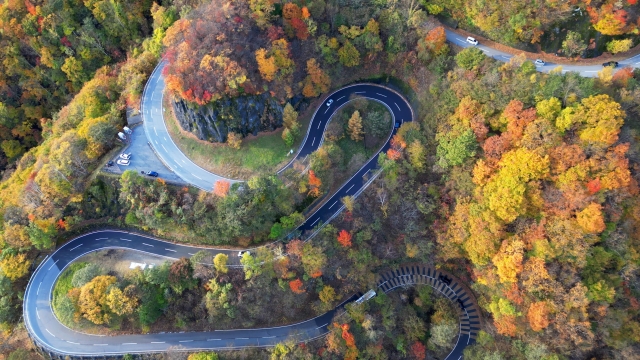
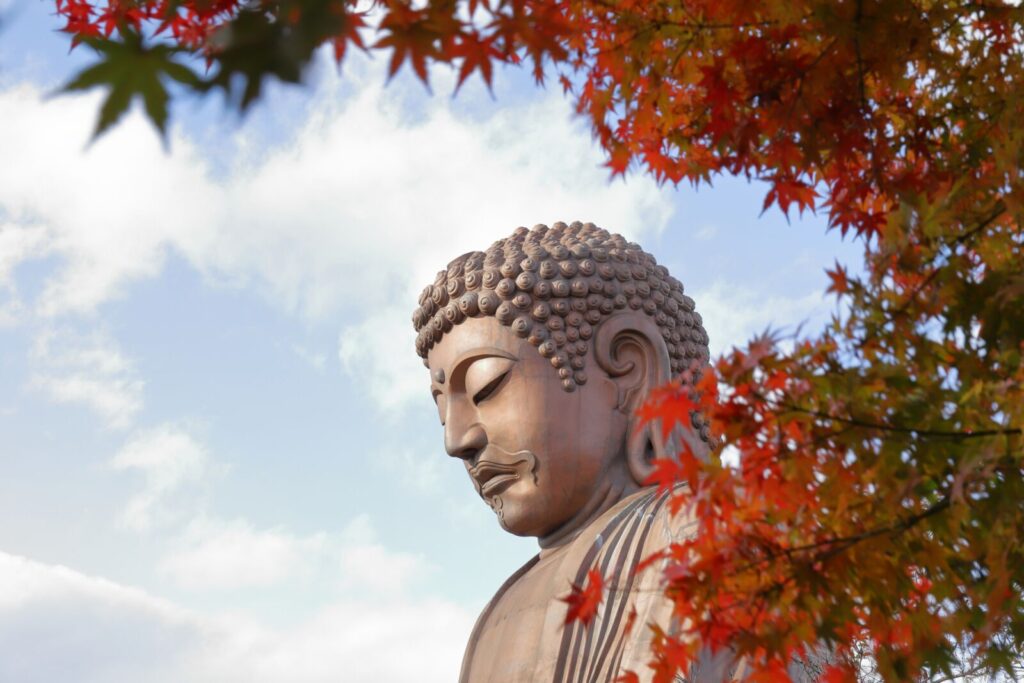
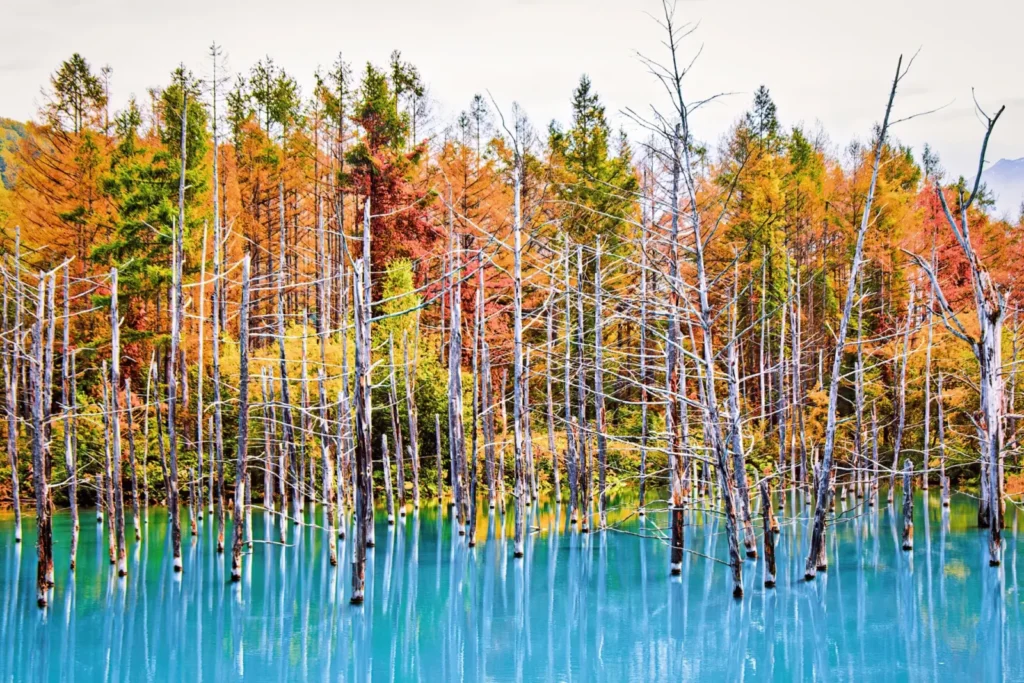
Each year, the Japan Meteorological Corporation (JMC) publishes its forecast for when they expect the leaves to change colors. As we move into autumn, you can expect the forecast to be refined with more exact dates.
The first Autumn Leaves forecast for 2025 was released on September 2nd. The forecast provides information on when the best times to see both red leaves and yellow leaves will likely happen. JMC updates their forecast throughout the fall, and we will update you with information as it becomes available.
When to See Red Maple Leaves in Japan
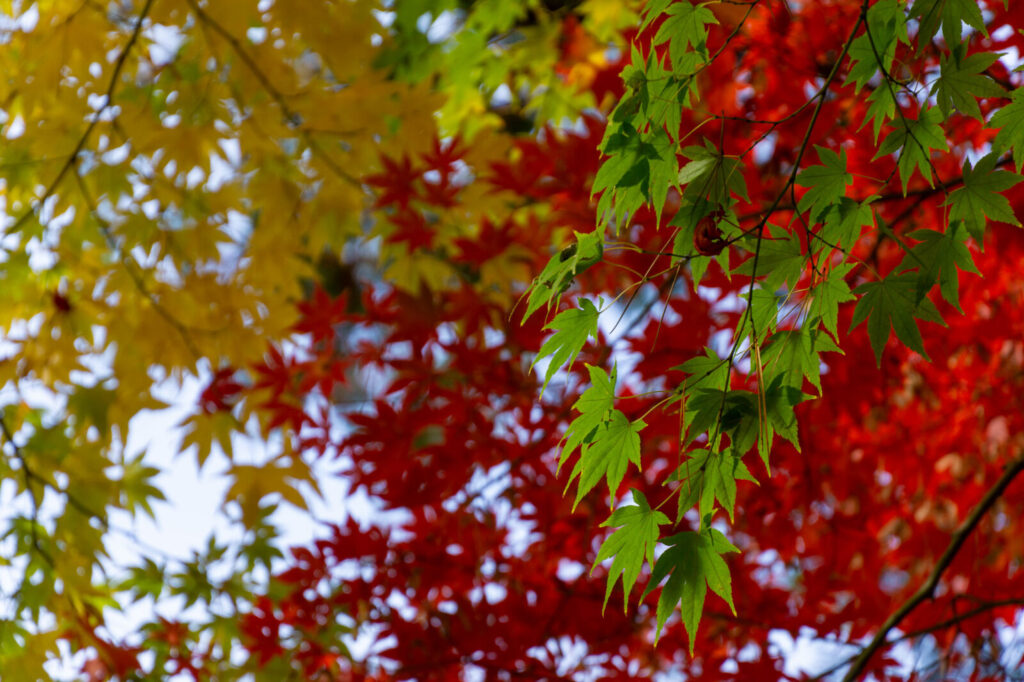
In Japan, several tree species display brilliant red foliage in autumn, most famously the Japanese maple (Iroha Momiji), known for its leaves that turn vivid shades of red, orange, and yellow. Other trees that contribute to the red hues include the Japanese stewartia, Japanese zelkova, burning bush (Nishikigi), and Japanese rowan (Nanakamado), each offering a variety of crimson or scarlet tones depending on the region and elevation. These trees help create the iconic autumn landscapes celebrated across the country during the koyo-season.
The map below is regarded as the main autumn leaves forecast however it specifically refers to when you can expect red and amber trees, such as 'momiji' (Japanese maples) to turn.

Overall, temperatures are higher than usual this year and the leaves will turn a little later in the areas of lower elevation. The highest mountain peaks will have colors from early October onwards, and with the large variation in elevation across Japan, you can expect a wide variance in the specific dates of peak color.
As you can see from the map above, many of our most popular fall leaf destinations in Nagano and the Japan Alps (located in the orange/red zone in the middle of Japan) are expected to be at peak colors at the end of October in areas of higher elevation - such as Shiga Kogen, Tateyama-Kurobe, Kamikochi and Togakushi- followed by lower areas from mid-November onward - such as Nagano City, Matsumoto, Hakuba, Nozawa Onsen and the Jigokudani Monkey Park.
Here are the forecasted dates for peak colors at some of our most popular fall leaf destinations:
- Kamikochi: October 24
- Korankei Gorge: November 25
- Kusatsu Onsen: November 5
- Minoh Falls: November 29
- Nakasendo Trail: November 21
- Shinhotaka Ropeway: October 27
- Snow Monkey Park: November 11
- Soni Highlands: November 24
- Takayama & Shirakawa-go: November 8
- Kurobe Gorge: November 13
- Togakushi: October 23
- Yoro: December 1
For other regions of Japan, the leaves are looking to be at peak around the usual time period, or a little later. The forecasted dates for best maple colors across Japan are as follows:
- Hiroshima: November 28
- Kanazawa: November 30
- Kyoto: December 12
- Nagoya: December 3
- Osaka: December 4
- Sapporo: November 7
- Tokyo: November 30
Of course, different areas within a city will have slightly different dates of peak color, and as the forecast is subject to change with a couple months to go until the peak season, it pays to keep a close eye on each new update.
When to See Yellow Leaves in Japan
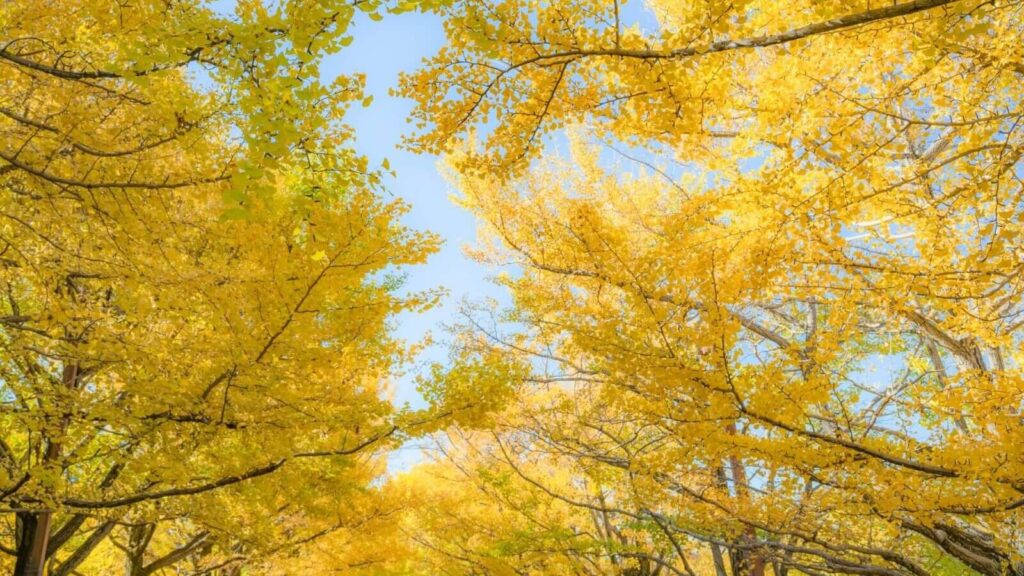
While red maples often steal the spotlight, golden trees add striking contrast and depth to the autumn scenery. Ginkgo trees line many streets and parks, especially in cities like Tokyo and Kyoto, while Japanese larches light up entire mountainsides in soft yellow tones in regions like Nagano and the Japanese Alps, creating breathtaking, golden landscapes.
Ginkgo trees (pictured above -- also spelled gingko, scientific name Ginkgo biloba) are ancient, deciduous trees known for their unique fan-shaped leaves and brilliant yellow color in autumn. They're often called "living fossils" because they have existed for over 200 million years and are the only surviving species in their plant division, Ginkgophyta.
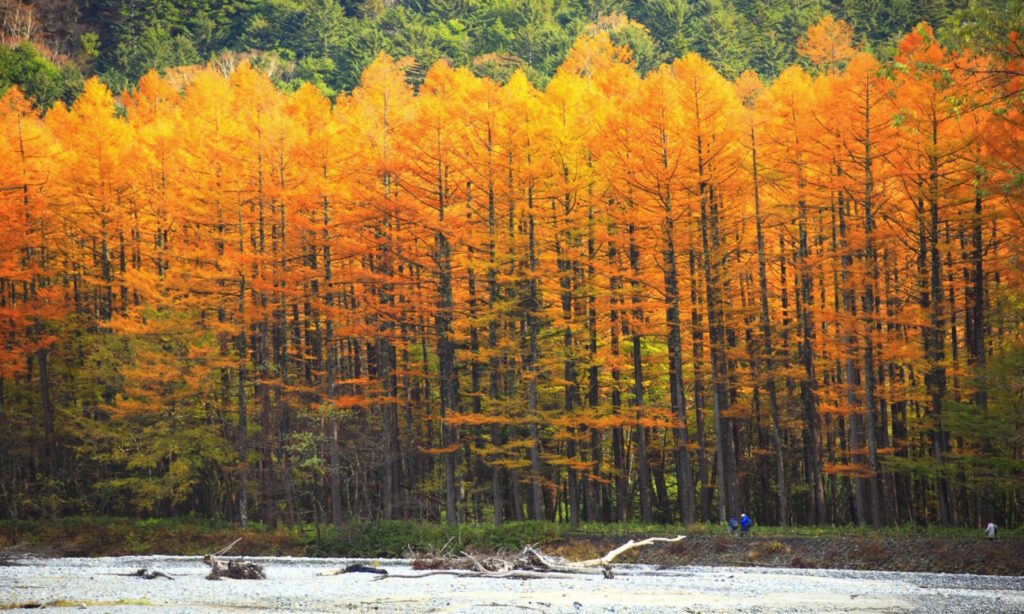
Japanese larch trees (Larix kaempferi) are a species of deciduous conifer native to Japan, particularly found in mountainous regions like Nagano, Gunma, and parts of Hokkaido. Unlike most conifers, which stay green year-round, Japanese larches shed their needles in autumn, turning a brilliant golden-yellow before falling.
The dates that yellow-leafed trees such as 'icho' (ginkgo) and 'karamatsu' (Japanese larch) are expected to turn, varies a little as shown on the map below.
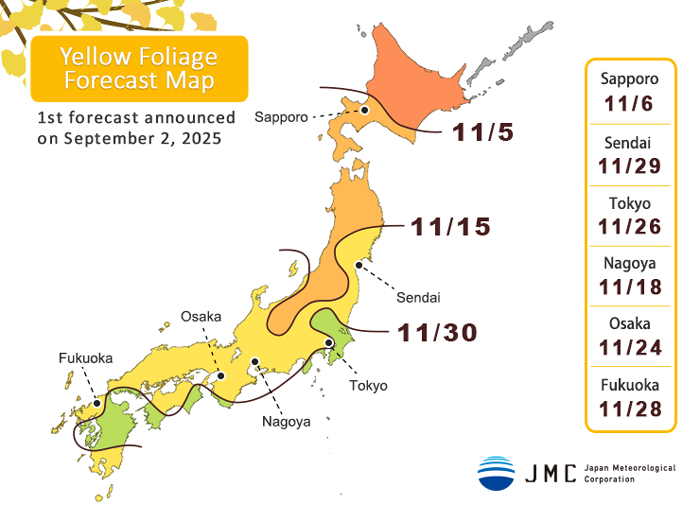
Peak colors for yellow colored leaves are typically earlier than red colored leaves (such as maple trees) in Japan. The forecasted dates for best yellow colors across Japan are as follows:
- Hiroshima: November 21
- Kanazawa: November 11
- Kyoto: November 28
- Nagoya: November 18
- Osaka: November 24
- Sapporo: November 6
- Tokyo: November 26
When planning your autumn visit and seeking-out the best spots to enjoy the leaves, our advice is to allow flexibility in your schedule so that you can move to the best areas as the condition of the leaves becomes more certain.
Weather and Packing Tips for Autumn in Japan
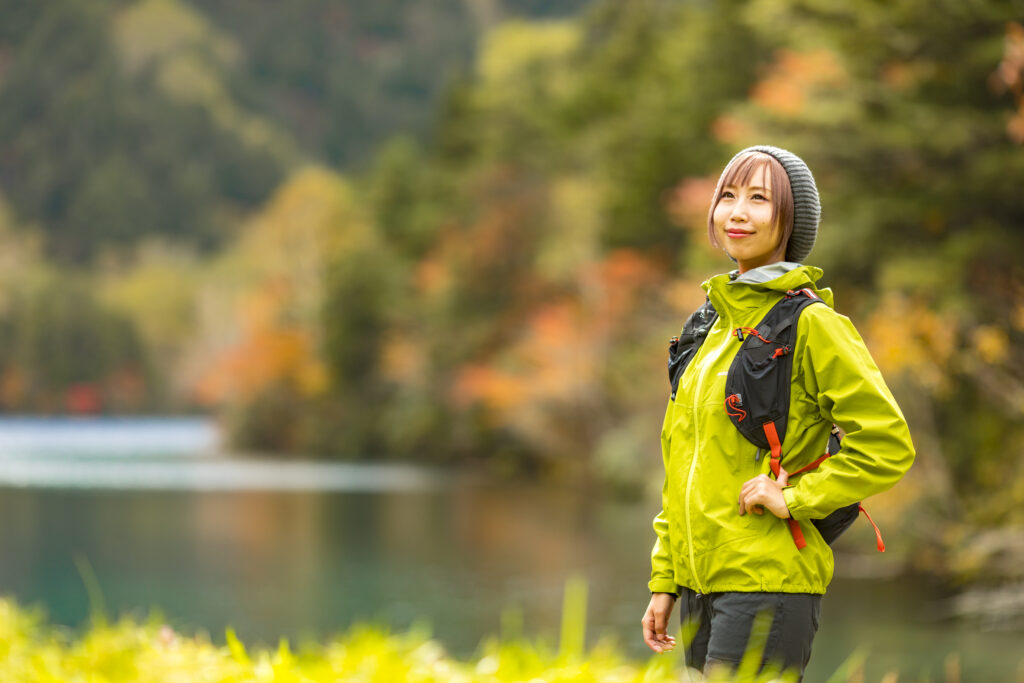
Autumn in Japan runs from late September to early December, offering ideal travel conditions with mild weather and breathtaking seasonal colors. Whether you're exploring city parks or hiking mountain trails, here’s what to expect and how to pack.
Tokyo, Kyoto & Osaka
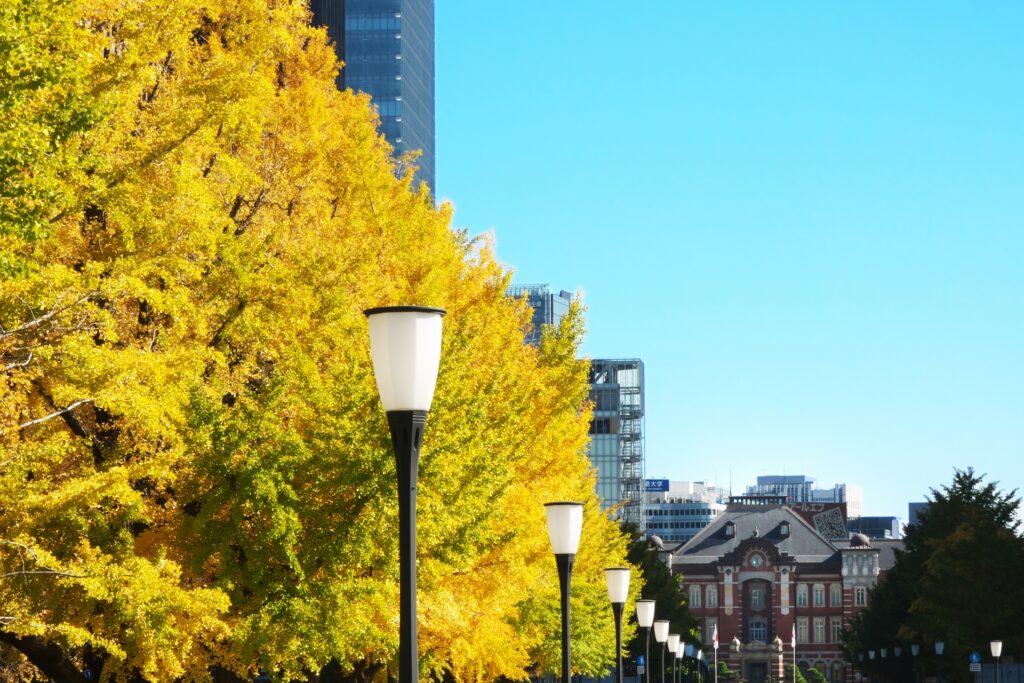
Autumn in Japan’s major cities is one of the best times to visit, offering mild temperatures and clear skies. Fall foliage peaks in mid-to-late November, making it perfect for outdoor sightseeing and cultural experiences.
Temperatures: 7–23°C (45–73°F) depending on the month
Conditions: Pleasant days with brisk mornings and cool evenings
Daytime packing list: Short or long sleeves, depending on the month; comfortable shoes for walking
Mornings/Night packing list: Light jacket or hoodie, especially in November
Tip from our local guides: Early mornings can feel chilly. Carry a compact outer layer if you're out all day.
Mount Fuji & the Japanese Alps

These high-altitude areas cool quickly, with temperatures dropping steeply by mid-autumn. The season brings breathtaking views, with vivid foliage and even early frost or snowfall in the upper elevations by November.
Temperatures: Often 0–15°C (32–59°F), colder at higher elevations
Conditions: Cold mornings, occasional frost, and rapidly changing mountain weather
Daytime packing list: Long sleeves and warm outer layers; good hiking shoes if exploring
Mornings/Night packing list: Windproof jacket, gloves, and a hat
Tip from our local guides: Be prepared for frost if you’re hiking or catching sunrise views. Layering is essential.
Hokkaido & Northern Japan
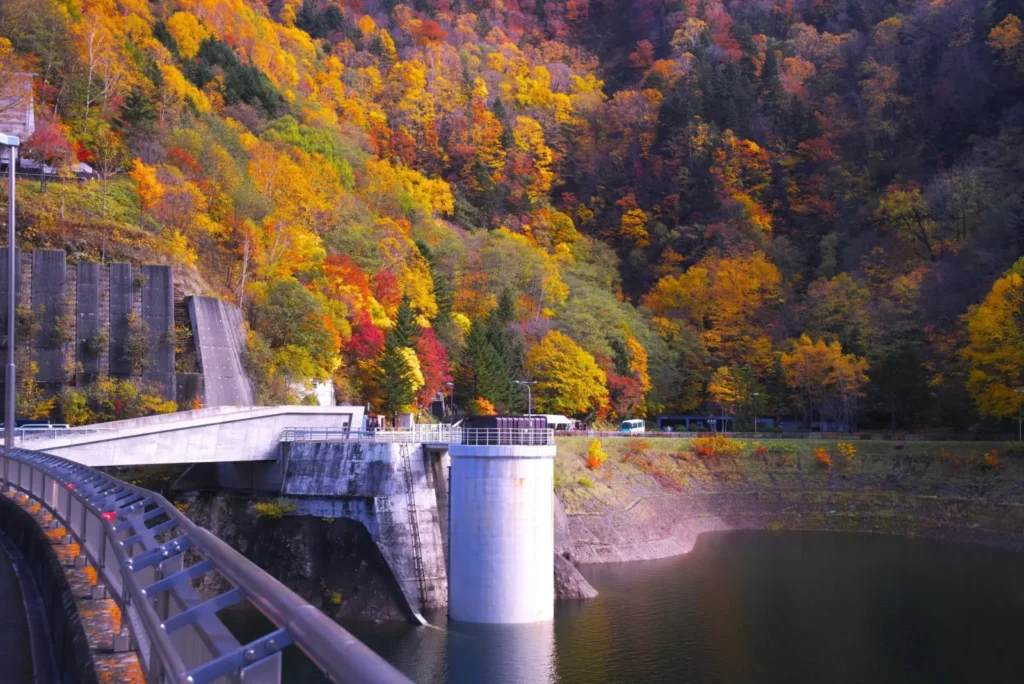
AAutumn arrives early in Hokkaido, with leaves turning as early as late September. By mid-October, it can already feel like winter, especially in the mountains, and snow may begin falling in higher elevations.
Temperatures: Often 5–10°C (41–50°F) or lower
Conditions: Chilly days, early snow possible in the mountains
Daytime packing list: Warm long sleeves, thermal base layers, and waterproof shoes
Mornings/Night packing list: Insulated coat, boots, warm hat, and gloves
Tip from our local guides: Northern Japan cools quickly. Dress for winter conditions if traveling in October or later.
Nagoya & Central Japan
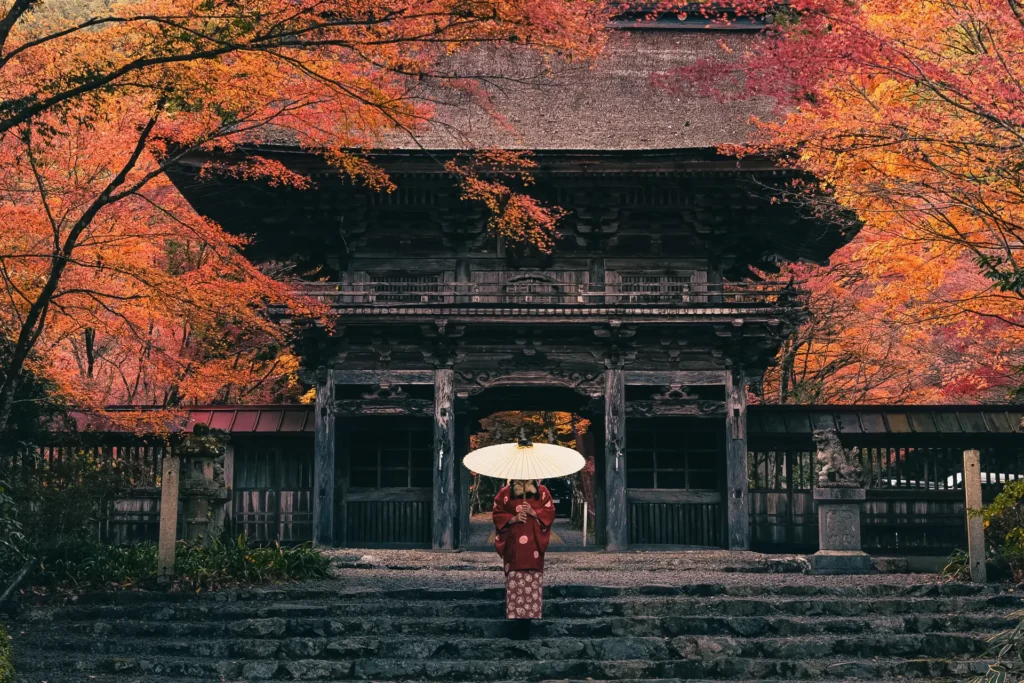
Autumn in Central Japan arrives gradually, with hot days lingering into mid-late October before cooling down in November. The region enjoys crisp air, clear skies, and some of the most stunning fall foliage in the country.
Temperatures: Typically 7–23°C (45–73°F) depending on the month and elevation
Conditions: Dry and sunny, with cooler mornings and evenings by November
Daytime packing list: Light layers or long sleeves; comfortable walking shoes
Mornings/Night packing list: A warm jacket or sweater, especially by late autumn
Tip from our local guides: Layering is key. Temperatures can shift quickly from day to night, especially in mountainous areas.
Hiroshima & Chugoku Region

The Chugoku region experiences a mild and comfortable autumn with fewer extremes than northern areas. Fall colors reach their peak in mid-to-late November, and the weather becomes very pleasant for sightseeing.
Temperatures: Around 10–22°C (50–72°F)
Conditions: Mostly sunny and dry, with cool evenings as the season progresses
Daytime Packing List: Long sleeves or light sweaters; breathable fabrics for afternoon walks
Mornings/Night Packing List: Medium-weight jacket or layered outerwear
Tip from our local guides: Coastal winds can make mornings feel chillier. Pack an extra layer if you're headed to the seaside.
Kyushu & Okinawa
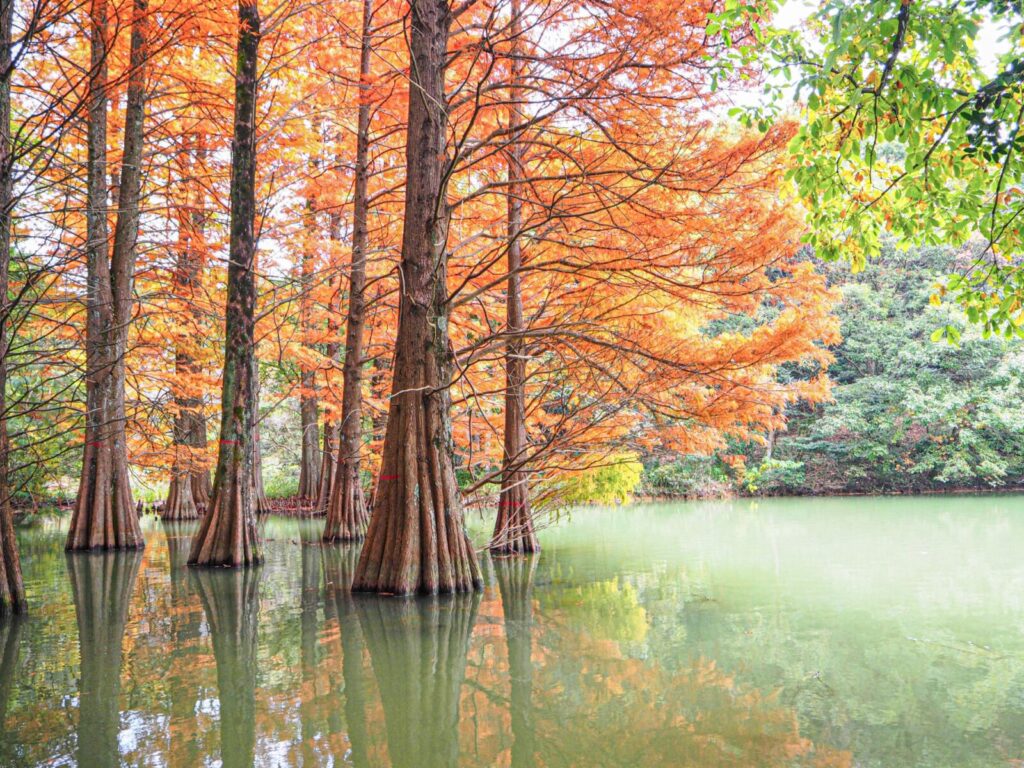
Autumn in Kyushu is mild and long-lasting, while Okinawa remains warm well into November. Foliage appears later in the season, especially in the higher elevations of Kyushu, while Okinawa may feel more like late summer.
Temperatures:
- Kyushu: 12–24°C (54–75°F)
- Okinawa: 20–27°C (68–81°F)
Conditions: Warm and humid in early autumn; cooler but pleasant by late November
Daytime: Short sleeves or light long sleeves; breathable, moisture-wicking clothing
Mornings/Nights: Light jacket or cardigan, especially in Kyushu’s inland areas
Tip from our local guides: Bring an umbrella or light rain jacket—brief autumn showers are common, especially in Kyushu
Get Started Planning your Trip to See Japan’s Autumn Leaves
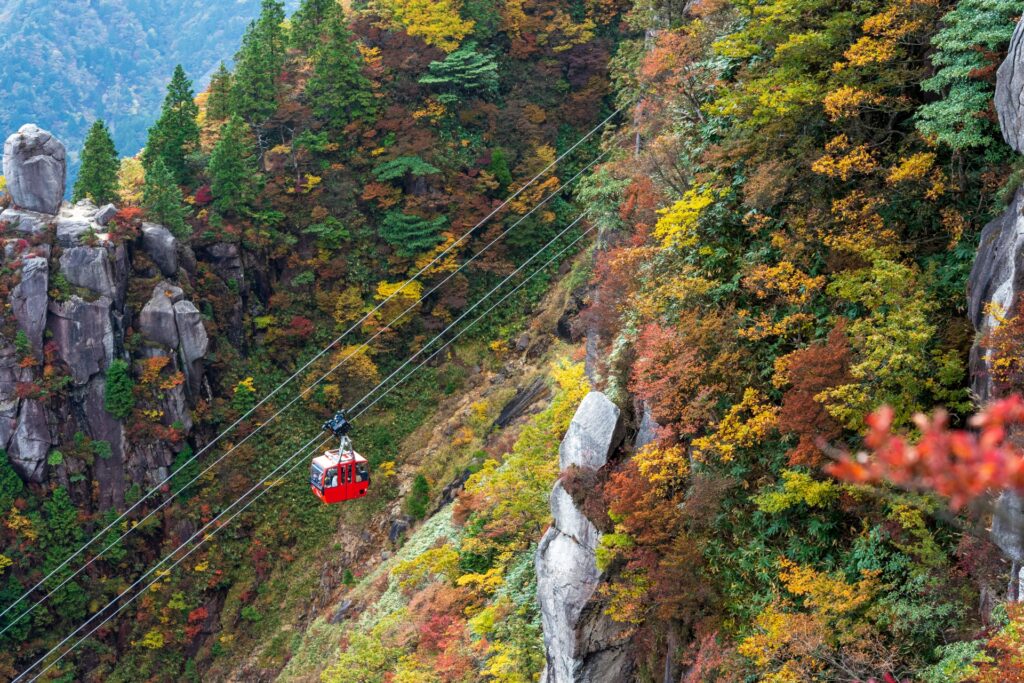
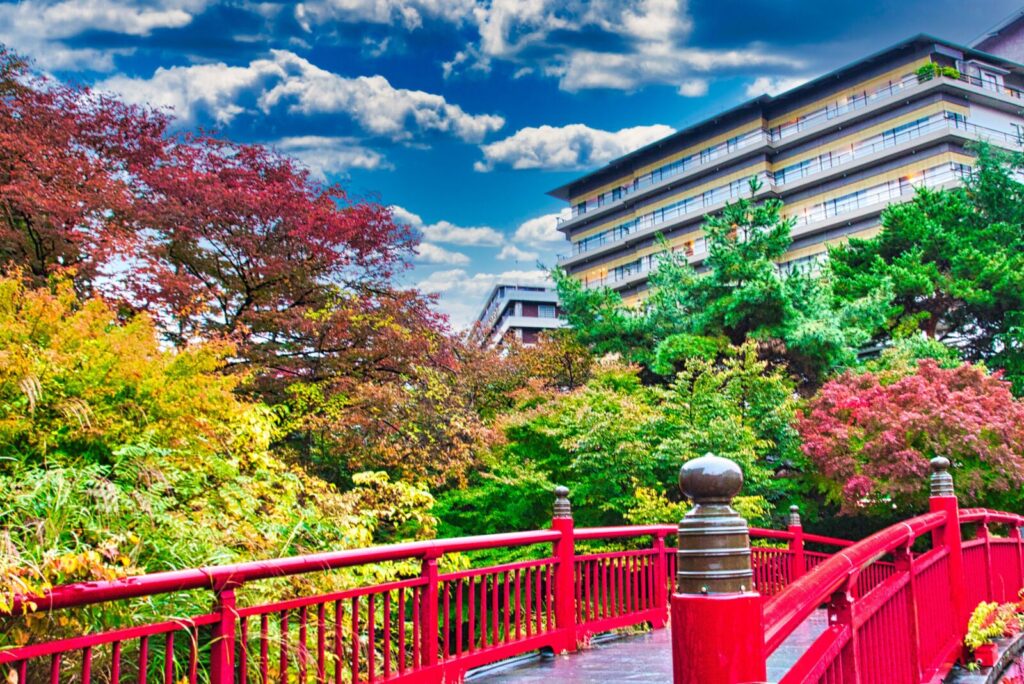
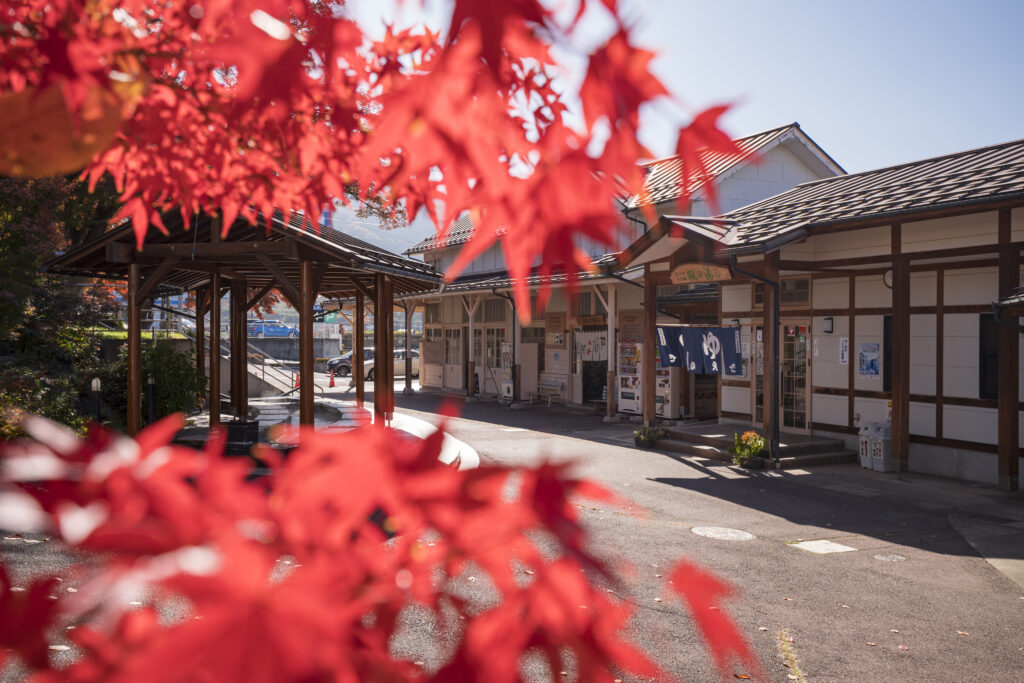

Travel to the most photogenic and interesting locations across Japan to see the iconic fall foliage with out the hassle of planning your itinerary or transportation. Choose from our wide variety of guided tours across Japan and catch the fall foliage at its peak.
From the high mountains of the Japanese Alps to the historic towns and gardens of Central Japan, our guide to the Best Tours to See Autumn Leaves in Japan lets you know the best places and the times to visit them to give you the best chance at filling your camera roll with stunning images of the foliage in Japan.
If you already have your itinerary planned out and are simply looking for some recommendations for were to see fall colors, check out our Regional Autumn Travel Guides for our local guides' favorite spots across Japan.
TOKYO | KYOTO | NAGOYA | HIROSHIMA | KANAZAWA | TAKAYAMA | NAGANO | JAPAN ALPS | MT. FUJI
Custom Charters for Autumn Leaves Viewing
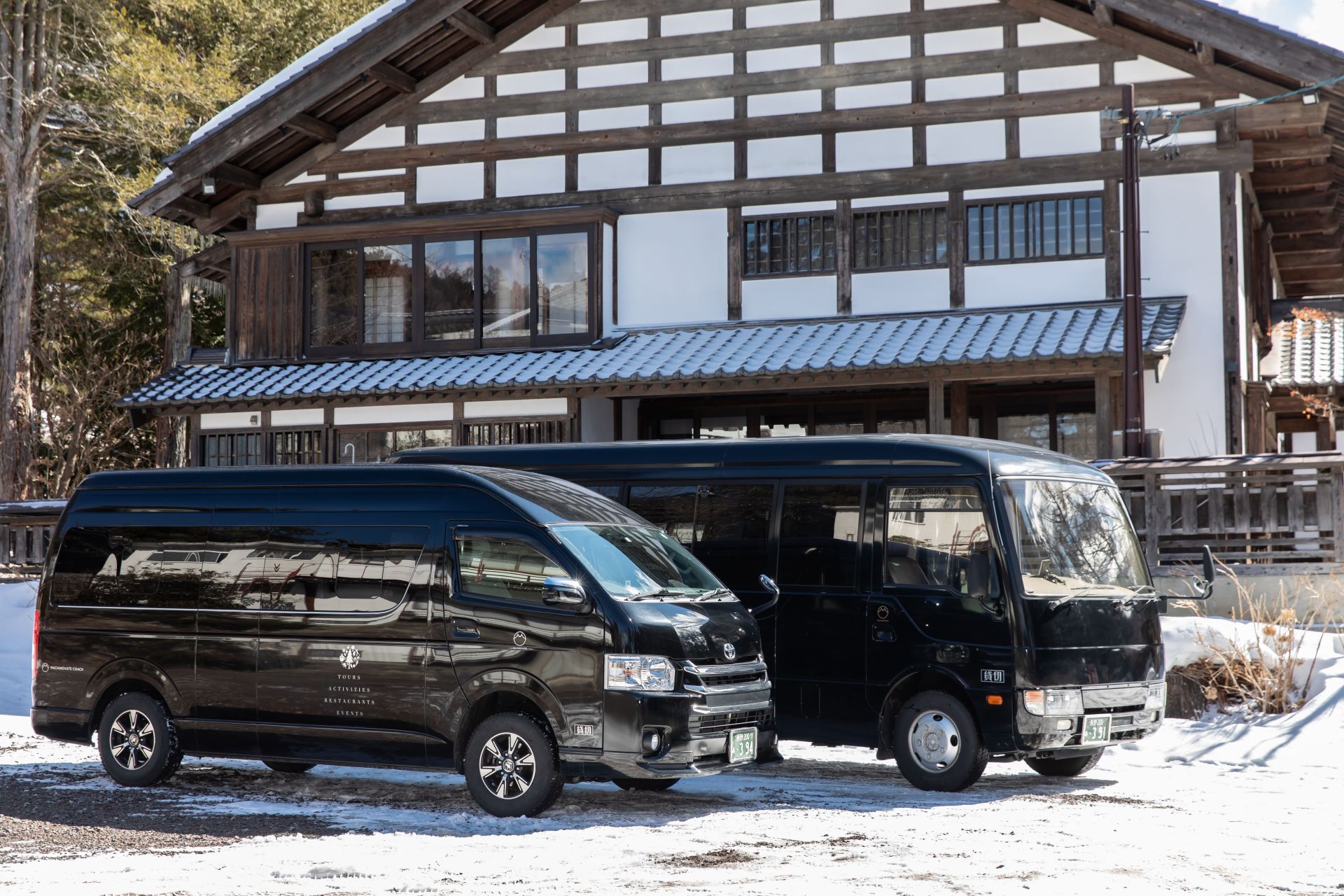
If you are looking for a more personalized trip, we also offer private charter services to bring you to wherever you want to go around the region. If you need suggestions, we are always ready to help you create the perfect itinerary for your travels. And, if you would like, we can even add a guide to make it a private tour for just your group! Please click HERE for more information on pricing and availability.



